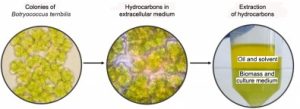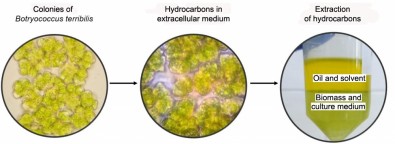
A group of researchers at the State University of Campinas (UNICAMP) in Brazil have grown microalgae under controlled conditions in a laboratory in order to use their metabolites, especially lipids, with the prime purpose of producing biofuel. The study is reported in an article published in the journal Biomass Conversion and Biorefinery.
“It’s also possible to extract protein and carbohydrates and use them as food, in addition to obtaining products that can be used in cosmetics, such as beta-carotene and other valuable compounds including phycocyanin, a natural blue pigment,” said Luisa Fernanda Ríos, second author of the article. The color of the sea and rivers is often largely due to the presence of microalgae, which can be blue, green or brown, she added.
Ríos and her co-authors are all affiliated with the Laboratory for Optimization, Design and Advanced Control (LOPCA) at UNICAMP’s School of Chemical Engineering (FEQ). The last author is Leonardo Vasconcelos Fregolente. The first is Bianca Ramos Estevam. The other co-author is Rubens Maciel Filho.
The study, which was supported by FAPESP, analyzed the growth and productivity of the microalga Botryococcus terribilis, comparing its behavior in closed and open systems. Closed systems, in which there is no exchange of air with the environment and the conditions can be tightly controlled, include photobioreactors. Open systems include raceways – shallow artificial ponds or channels where microalgae, water and nutrients circulate, and air is exchanged with the environment.
According to the article, proteins, carbohydrates, lipids, pigments, and hydrocarbons were extracted and quantified. This was the first time hydrocarbons extracted from B. terribilis were characterized. “Studies on B. terribilis cultivation have great economic and environmental relevance but are scarcely addressed in the literature,” the authors state.
“Microalgae are the most ancient microorganisms and produce as much as 50% of the oxygen we breathe,” Ríos said. “Microalgae and fungi together created the organic matter we know today as plants.”
Like plants, microalgae grow through photosynthesis, converting atmospheric carbon dioxide, water and sunlight into energy and generating oxygen as a byproduct. The resulting metabolites include proteins, carbohydrates and lipids, as well as carotenoids, chlorophyll and vitamins in smaller quantities.
Petroleum also contains microalgae deposited on the seabed and deep underground in its composition. “Imagine the many important things there are in the cells of these organisms,” said Ríos, who has a PhD in chemical engineering from UNICAMP.
Stress
Microalgae are unicellular and reproduce by mitosis: each cell divides into two identical daughter cells, resulting in exponential multiplication. “We grow microalgae in the lab to take advantage of all these biocompounds in their cells. We have to kill them in order to do so, but this isn’t a concern as they grow very fast and are always abundant,” Ríos said.
B. terribilis oils are suitable for biofuel synthesis, as they are made up of long-chain hydrocarbons, as well as larger amounts of saturated and mono-unsaturated fatty acids. The study helps fill the information gap on cultivation, stress and composition of these microalgae, supporting decisions relating to cultivation parameters and biorefinery applications.
Stress in this case means a lack of key growth nutrients such as phosphorus or nitrogen. “When the organism senses a lack of these nutrients, it starts to accumulate lipids in order to survive. We used this ability as a strategy to create an accumulation of the metabolite of interest. In other words, we stressed the organism by eliminating nutrients needed for growth. At the same time, because it grew more slowly, the proportion of other metabolites such as proteins and carbohydrates decreased. It’s important to identify the compound of interest and make sure to achieve the right balance for the study,” Ríos said.
Stress increased the production of lipids and hydrocarbons by 49% and 29% respectively, but proteins decreased from 32% of the total composition to 26%. The proportions of carbohydrates (15% of the total) and pigments (0.41%-0.86%) was similar in stressed and unstressed growth.
The article “Effects of cultivation systems and nutrient limitation on the growth and metabolite biosynthesis of Botryococcus terribilis” is at: link.springer.com/article/10.1007/s13399-023-03805-w.
This text was originally published by FAPESP Agency according to Creative Commons license CC-BY-NC-ND. Read the original here. By Ricardo Muniz | Agência FAPESP

